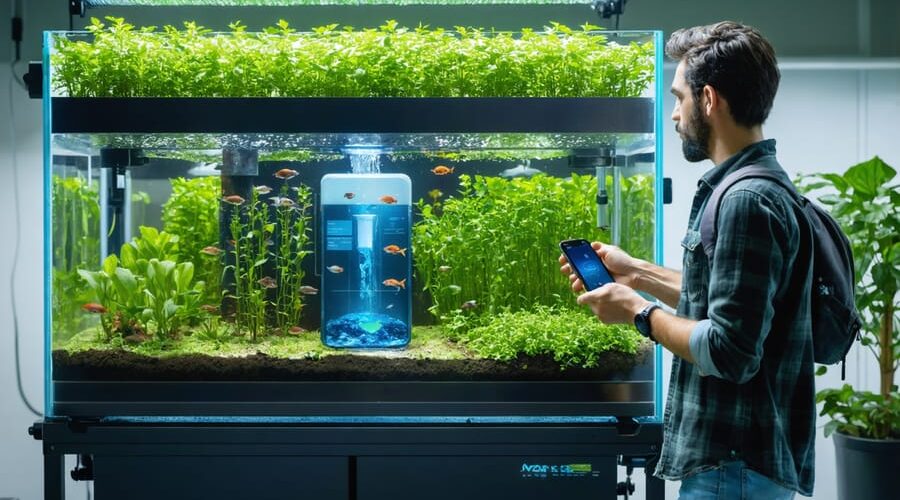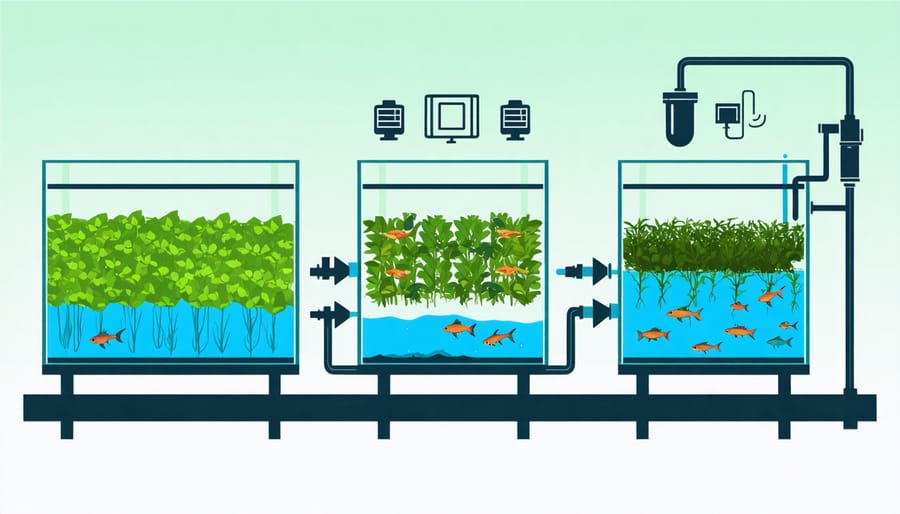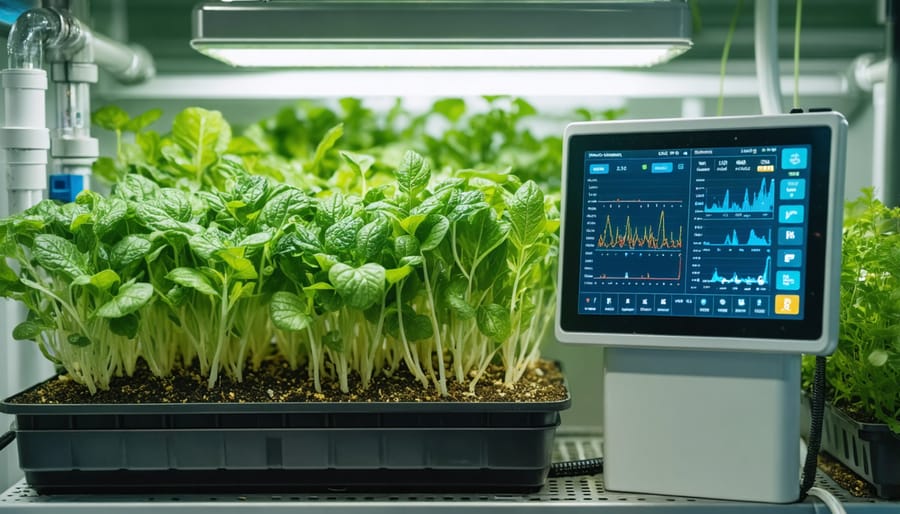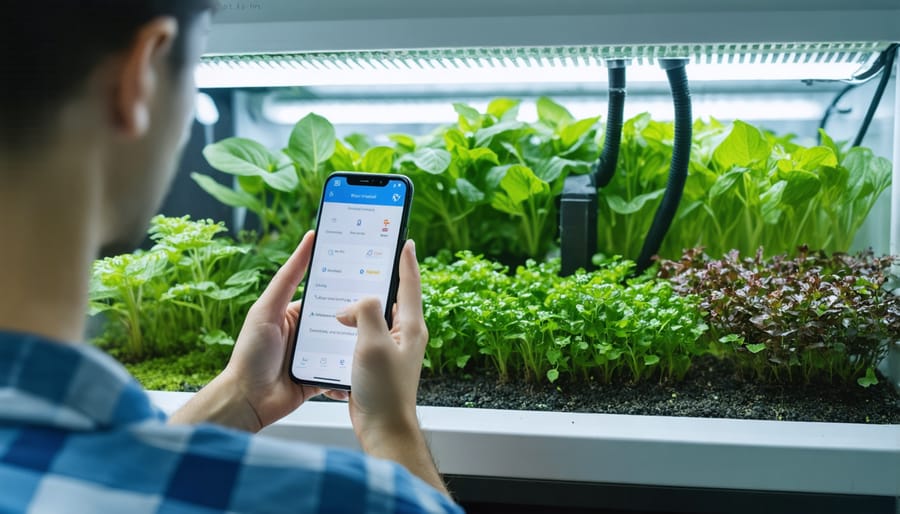
Smart Aquaponics: How Modern Technology is Revolutionizing Fish and Plant Growing
Discover the groundbreaking fusion of aquaculture and hydroponics in modern aquaponic systems – a sustainable ecosystem where fish and plants thrive together in perfect harmony. This innovative farming method creates a closed-loop environment where fish waste provides essential nutrients for plants, while the plants naturally filter water for the fish, eliminating the need for traditional fertilizers and reducing water consumption by up to 90% compared to conventional farming.
Today’s automated aquaponic systems leverage smart technology to monitor water quality, regulate temperature, and maintain optimal growing conditions with minimal human intervention. From compact indoor units perfect for urban gardeners to large-scale commercial operations, aquaponics represents the future of sustainable food production. Whether you’re a curious hobbyist or an aspiring urban farmer, understanding the fundamentals of aquaponics opens the door to growing fresh, organic produce and raising healthy fish in your own space.
This symbiotic growing method not only produces chemical-free food but also offers a practical solution to modern agricultural challenges while promoting environmental stewardship.
What Makes an Aquaponic System Smart?
Core Components
Every successful aquaponic system relies on several essential components that work together to create a thriving ecosystem. The fish tank, or aquaculture tank, serves as the heart of the system, housing fish that produce nutrient-rich water. This tank needs to be properly sized to ensure your fish have enough space to grow healthily.
The grow beds are where your plants flourish, typically filled with a growing medium like expanded clay pebbles or gravel. These beds receive the nutrient-rich water from the fish tank, allowing plants to filter out the nutrients they need while cleaning the water for the fish.
A robust filtration system keeps everything running smoothly. This usually includes mechanical filters to remove solid waste and biological filters where helpful bacteria convert fish waste into plant-friendly nutrients. Don’t forget the pumps and plumbing that keep water flowing between components – they’re like the circulatory system of your aquaponics setup!

Smart Technology Integration
Modern aquaponic systems have embraced smart technology to make monitoring and maintenance easier than ever. At the heart of these innovations are sensors that keep track of crucial water parameters like temperature, pH levels, and dissolved oxygen. These digital helpers work around the clock, giving you real-time updates about your system’s health.
Smart controllers act as the brain of your setup, automatically adjusting water flow, feeding schedules, and lighting based on the data they receive. Many systems now come with user-friendly apps that let you monitor everything from your smartphone, perfect for checking on your plants and fish even when you’re away.
For beginners, basic monitoring systems might include simple temperature sensors and automated feeders. More advanced setups can feature water quality probes, automated pH adjusters, and even cameras to watch fish behavior. The beauty of smart integration is that it’s scalable – you can start small and add components as you become more comfortable with the technology.
These smart features not only make aquaponics more accessible but also help prevent common problems before they become serious issues, giving you peace of mind and better results.
Key Automation Features
Water Quality Monitoring
Modern water quality monitoring in aquaponic systems has become incredibly user-friendly thanks to smart sensors. These clever devices act like vigilant guardians, keeping a constant eye on the vital signs of your system. Think of them as health monitors for your aquaponic ecosystem!
The most essential sensors track three key parameters: pH levels, water temperature, and nutrient concentrations. pH sensors help you maintain the perfect balance between 6.0 and 7.0, ensuring both fish and plants thrive. Temperature sensors alert you if the water gets too warm or cold, protecting your fish from stress. Nutrient sensors measure important elements like nitrogen, helping you know when to adjust feeding schedules.
What makes these sensors truly “smart” is their ability to connect to your smartphone or computer. Many models send real-time alerts when something needs attention, so you can respond quickly to any changes. Some systems even automatically adjust themselves, adding the right amount of nutrients or adjusting water flow as needed.
For beginners, these sensors take the guesswork out of aquaponics. Instead of wondering if your system is healthy, you’ll have clear, easy-to-understand data right at your fingertips. The best part? Many affordable options are available, making smart monitoring accessible for home systems of any size.

Feeding Systems
Modern aquaponic systems employ smart feeding technologies to ensure both fish and plants receive optimal nutrition. Automatic fish feeders can be programmed to dispense precise amounts of food at scheduled intervals, preventing overfeeding and maintaining water quality. These feeders range from simple timer-controlled devices to sophisticated systems that can adjust portions based on fish size and water temperature.
For plant nutrition, automated dosing systems work in harmony with the fish feeding schedule to maintain perfect nutrient management throughout the system. Water pumps and distribution networks ensure that nutrient-rich water from the fish tank is evenly delivered to growing beds, while monitoring systems track essential parameters like pH and nitrogen levels.
Many hobbyists start with basic timer-controlled systems and gradually upgrade to more advanced options. A simple yet effective setup might include a battery-operated fish feeder and a reliable water pump with adjustable flow rates. For those looking to scale up, smart controllers can integrate multiple feeding zones, monitor water quality, and even send alerts to your smartphone when attention is needed.
Remember to regularly check and maintain your feeding equipment, as reliable automation is key to a thriving aquaponic ecosystem. Start simple and expand your system’s capabilities as you gain experience.
Environmental Control
Modern aquaponic systems thrive on precise environmental control, making it easier than ever to maintain ideal growing conditions. Temperature, lighting, and humidity all play crucial roles in the success of your system, and today’s automation technology helps manage these factors effortlessly.
For temperature control, smart thermostats can maintain water temperatures between 68-75°F (20-24°C), which suits most fish species and plants. These devices can trigger heaters or chillers as needed, ensuring your aquatic friends stay comfortable year-round.
Lighting automation is another game-changer for indoor systems. LED grow lights with programmable timers mimic natural daylight cycles, providing plants with the perfect amount of light for photosynthesis. Many modern setups allow you to adjust light intensity and duration based on the growth stage of your plants.
Humidity control systems help prevent issues like mold growth while maintaining optimal moisture levels for plant health. Smart sensors can activate fans or dehumidifiers when needed, creating a balanced environment for both the aquatic and hydroponic components.
The best part? You can monitor and adjust all these parameters through your smartphone. Many systems now offer apps that send alerts if conditions fall outside optimal ranges, giving you peace of mind and the ability to respond quickly to any changes in your ecosystem.
Benefits of Smart Aquaponics
Enhanced Efficiency
Automation has revolutionized aquaponic systems, making them more efficient and easier to manage than ever before. Smart sensors monitor water quality, temperature, and pH levels in real-time, automatically adjusting conditions when needed. This eliminates the need for constant manual testing and adjustments, saving countless hours of work.
Automated feeders ensure fish receive the right amount of food at scheduled times, preventing overfeeding and maintaining optimal water quality. Smart pumps adjust water flow rates based on plant needs and system conditions, while automated ventilation systems regulate greenhouse temperatures and humidity levels.
Many modern systems include mobile apps that let you monitor and control your setup remotely. You’ll receive instant alerts if something needs attention, allowing you to address issues before they become problems. These technological advances mean you can maintain a thriving aquaponic system with just minutes of oversight per day.
The best part? As automation technology becomes more accessible and affordable, even small-scale hobbyists can implement these time-saving features in their systems. This means more time enjoying your aquaponic garden and less time managing it.
Remote Management
Remote management has revolutionized how we operate aquaponic systems, making it easier than ever to maintain a thriving ecosystem. With smart technology, you can monitor and control your system from anywhere using your smartphone or computer. Imagine checking your water temperature while on vacation or adjusting pump settings during your lunch break at work!
These remote capabilities allow you to track crucial parameters like pH levels, water temperature, and nutrient concentrations in real-time. You’ll receive instant alerts if anything needs attention, helping prevent potential problems before they affect your fish or plants. This proactive approach not only saves time but also reduces stress and ensures better outcomes for your aquaponic garden.
Many modern systems come with user-friendly apps that display easy-to-read dashboards and graphs, making it simple to spot trends and make informed decisions. You can even automate routine tasks like feeding schedules and water cycling, giving you more time to enjoy the benefits of your aquaponic system rather than constantly managing it.
For busy gardeners, remote management is truly a game-changer, offering peace of mind and consistent results with minimal hands-on effort.

Automation has revolutionized the way we approach aquaponics, making these sustainable food production systems more accessible and manageable than ever before. By incorporating smart technology, sensors, and automated controls, modern aquaponic systems can maintain optimal growing conditions with minimal human intervention. This not only reduces the daily maintenance requirements but also leads to better crop yields and healthier fish populations.
The integration of automation helps maintain consistent water quality, regulated feeding schedules, and precise environmental controls – critical factors that once required constant manual monitoring. For home gardeners and commercial growers alike, these technological advances mean more reliable harvests and fewer system failures. They also make aquaponics a viable option for busy individuals who want to grow their own food but have limited time for daily system maintenance.
Looking ahead, automation will continue to play a crucial role in the evolution of aquaponics. As technology becomes more affordable and user-friendly, we can expect to see even more innovative solutions that make these systems increasingly efficient and accessible to everyone interested in sustainable food production.
